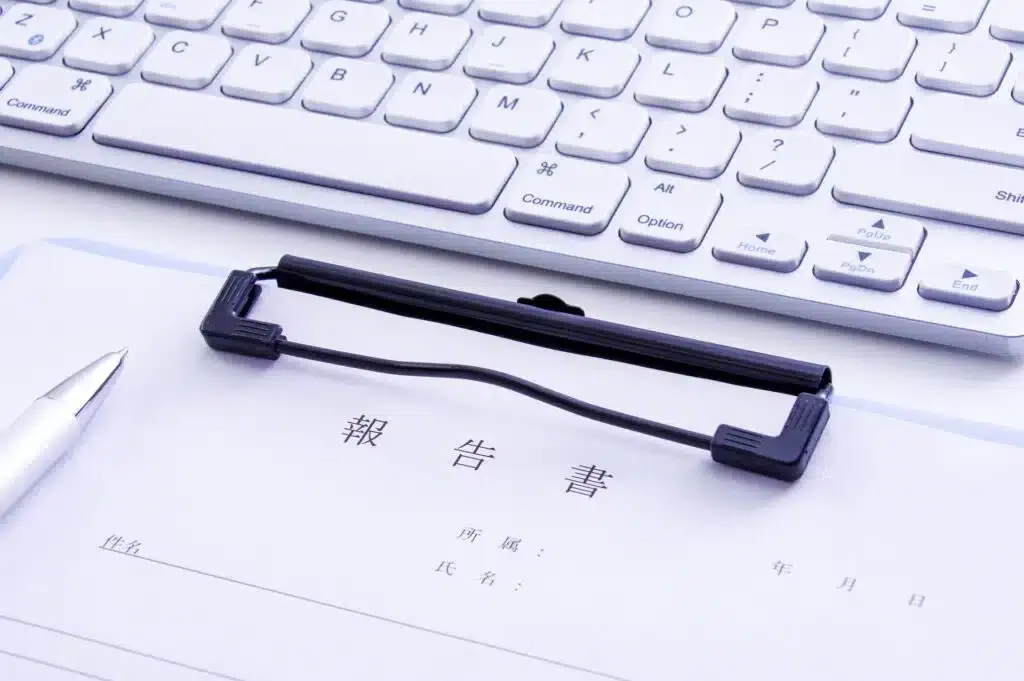The Importance of Nursing Care Incident Reports: How to Write Them and Points to Note

When an accident occurs at a care facility, it is necessary for the facility to create a Japanese Care Accident Report. A Japanese Care Accident Report is a document submitted as a report when a care accident occurs. This report clearly and concretely details the specifics of the accident.
This article will explain the items that should be included in a Japanese Care Accident Report and the points to note when creating one. Please use this as a reference when preparing your report.
What is a Nursing Care Incident Report?

For nursing care facility operators, understanding the definition of a nursing care incident report, the legal obligation to report, and the role of the report is crucial. Prompt response to incidents when they occur leads to the sound management of a nursing care facility. We will explain each of these aspects in detail.
Definition of Nursing Care Incident Report
A Nursing Care Incident Report is a document used to report the details of an accident that occurs in a long-term care insurance facility to the authorities. When an accident occurs at a facility operated by a nursing care service provider, it is mandatory to report it to the municipality where the facility is located. The purpose of the Nursing Care Incident Report is to clarify the nature and cause of the accident, as well as the measures to prevent its recurrence, thereby aiming to improve the quality and safety of nursing care services.
The Nursing Care Incident Report includes details of the accident that occurred, the response at the time of the accident, identification and analysis of the cause of the accident, and the measures to prevent recurrence and improvement plans.
Legal Obligations and Necessity of Nursing Care Accident Reports
Nursing care facilities are obligated to report to the administration in the event of an accident, depending on the nature of the incident. The following are accidents in nursing care that require reporting to the administration:
- Accidents resulting in death
- Accidents requiring treatment such as medication or medical procedures following a diagnosis by a physician (including those employed or stationed at the facility)
For accidents other than those mentioned above, the necessity of reporting is determined based on guidelines set by each local government. Some local governments may require reports even for minor accidents, so it is important to check the regulations of the local government.
The initial report is recommended to be made within 5 days of the accident occurrence, including a preliminary report by phone and submission of the report. It is crucial to prepare the report promptly within this period and submit it to the relevant authorities.
Furthermore, if the situation of the accident changes or additional investigation is required, subsequent reports may be made. This is to provide additional information as needed and to appropriately understand the situation.
The Role of Nursing Care Accident Reports
The creation of nursing care accident reports serves several important roles.
The first is the prevention of recurrence of nursing care accidents. During the process of creating the report, the background and causes of the accident are analyzed in detail. This process allows for the development and implementation of preventive measures to ensure that similar accidents do not happen again.
The second is the improvement and enhancement of the quality of nursing care services. Nursing care accident reports serve as a valuable source of information to identify issues with care services and aid in their improvement. Based on the reports, enhancements in the methods of service provision and the environment can be made, leading to an overall improvement in the quality of care.
The third role is sharing detailed information about nursing care accidents with all employees. Nursing care accident reports are tools for informing the entire staff about the circumstances and causes of accidents and future countermeasures, fostering a common understanding. This enhances safety awareness within the facility and strengthens the response capabilities of the organization as a whole.
The fourth role is as evidence in litigation. Nursing care accident reports may be submitted as evidence or used to determine liability in cases where users or their families file lawsuits against nursing care facilities or their employees for damages. Claims may be based on breaches of the duty of care or the duty of attention, leading to non-performance of obligations. When a trial takes place, the accident report becomes crucial evidence in determining whether the facility and employees fulfilled their duties.
Related article: What happens if you are sued for a nursing care accident? A thorough explanation of the facility’s liability and countermeasures[ja]
Basic Structure of Nursing Care Incident Reports

When nursing care providers create incident reports, it is crucial to understand the basic structure and necessary details to include, ensuring the report is accurate. Below, we will explain the mandatory items to include and measures to prevent recurrence.
Verification of Mandatory Items
The items and content that should be included in a nursing care incident report are as follows:
| Item | Content |
| Incident Details | Detailed description of the incident, type of medical consultation, hospitalization, death, etc., extent of the incident |
| Facility Overview | Corporate name, facility name, facility number, type of service, location |
| Subject | Information on the user who was injured or suffered damage due to the care incident |
| Incident Summary | Date and time of the incident, location, type of incident, situation at the time of occurrence, detailed description of the incident |
| Response at the Time of Incident | Immediate response, method of medical consultation, destination, diagnosis name, content of diagnosis, summary of tests and treatments, etc. |
| Post-Incident Situation | User’s condition, reports to family, related organizations contacted, additional follow-up plans for the individual, family, and related parties |
| Cause Analysis | Factors related to the individual, staff, and environment |
| Measures to Prevent Recurrence | Preventive measures corresponding to the causes |
| Other | Content that should be included in addition to the above |
When documenting a nursing care incident report, it is important to describe the objective facts of the incident so that anyone can understand. Additionally, the use of specialized terms and abbreviations should be minimized, as they may not be understood by external parties.
In each municipality, there may be a prescribed format for the report. If no specific format is set, the report should be created to cover the items listed above.
Chronological Recording of Facts
In creating a nursing care incident report, accurately recording the progression of events in chronological order is crucial for analyzing the causes and devising measures to prevent recurrence.
Organize and accurately record the flow from the occurrence of the incident to the response. Clearly describe the incident details, date and time of occurrence, situation at the time, and information about the family and related parties.
Clarification of Measures to Prevent Recurrence
For preventive measures, it is important to implement specific strategies for each factor. For example, revising individual care plans for personal factors, training or operational improvements for staff factors, and safety checks of facilities for environmental factors.
Moreover, the measures should be realistic and practicable by all employees. Overly complex strategies may prove difficult to implement in practice.
Furthermore, it is essential to verify in advance whether the measures, once implemented, will effectively prevent accidents and to choose methods that are expected to be effective.
Key Points in Creating Nursing Care Incident Reports

What are the key considerations when creating nursing care incident reports? Below, we discuss the prohibition of false entries, the protection of personal information, and the importance of information sharing.
Prohibition of False Entries and Ethical Considerations
The creation of nursing care incident reports aims to prevent the occurrence and recurrence of accidents and to improve and enhance the quality of care services. Therefore, it is essential to record objective information based on facts.
Sharing the details of the accident with all employees is also crucial to accurately understand the incident. Including false information in the nursing care incident reports can lead to inadequate implementation of recurrence prevention measures, increasing the risk of repeated accidents.
Consideration for the Protection of Personal Information
Since nursing care incident reports contain personal information of users and related parties, it is necessary to manage this information in compliance with the Japanese Personal Information Protection Law. When recording personal information in the report, only include the necessary scope of personal information and avoid noting any unnecessary details. In particular, information that can identify individuals, such as names, addresses, and contact details, requires strict management.
When setting up opportunities to share information among facility management stakeholders, it is also essential to establish a system that prevents information leaks in handling personal information.
The Importance of Prompt Reporting and Information Sharing
Nursing care incident reports serve not only as records but also as tools for notifying all stakeholders and sharing response measures. As all staff work in the same workplace or environment, there is a potential for anyone to be involved in an accident. If the details of past accidents are not accurately communicated to all parties, the risk of similar incidents recurring increases.
By conducting meetings based on the reports to prevent the recurrence of accidents, we can implement precise safety measures. Incident reports are crucial not only for individual accident responses but also for enhancing the overall safety of the workplace through prompt sharing.
Summary: Understanding the Importance of Nursing Care Incident Reports and Proper Documentation

The creation of nursing care incident reports in nursing facilities is mandated by law and plays an essential role in preventing accidents and their recurrence throughout the facility.
In nursing facilities, the highest priority is to protect the health and safety of the elderly, but no matter how careful we are, the reality is that it is difficult to completely prevent accidents.
Therefore, it is crucial for the entire facility to raise awareness about accidents and, when an accident does occur, to respond swiftly and accurately, and to implement measures to prevent recurrence.
Guidance on Measures by Our Firm
The caregiving industry is governed by a complex web of laws, including the Japanese Long-Term Care Insurance Act, the Japanese Elderly Welfare Act, and the Japanese Companies Act. Monolith Law Office serves as the legal advisor for the National Association of Caregiving Service Providers and caregiving service providers in prefectures nationwide, possessing extensive know-how related to legal matters in the caregiving business.
Areas of practice at Monolith Law Office: Corporate Legal Affairs for IT & Startups[ja]
Category: General Corporate
Tag: General CorporateIPO





















